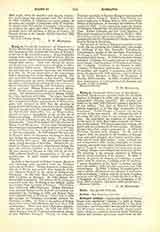

Kickapoo Indians. —Apparently corrupted from a longer term signifying “roamers”: a tribe of Algonquian stock, closely related dialectically to the Sauk and Foxes, and living when first known in south central Wisconsin, whence they gradually moved southward, taking up a position about the lower Wabash in Illinois and Indiana, upon lands seized from the Illinois and Miami. In their general habit, as well as in their mythology and ceremonial forms, they closely resembled the Sauk and Foxes. They were agricultural, occupying fixed villages of bark houses in summer an oval mat-covered lodges in winter, and making frequent excursions into the plains beyond the Mississippi to hunt the buffalo and steal horses. As the name implies they were noted for their roving and adventurous disposition. Their religious belief centered about two mythic hero brothers, to whom all good was attributed and who ruled over life in the spirit world. They held the dog particularly sacred. They had a system of eleven clans (see Indians), which is still kept up, descent following the male line, and the name of the individual indicating the clan to which he belonged. As a people the Kickapoo have usually been hostile to the white man and his civilization. They are possibly identical with a tribe mentioned by the Jesuit Druillettes in 1658, but were first definitely met by Allouez about 1669, as visitors, with other tribes, at the Francis Xavier Mission, on Green Bay, Wisconsin. In 1680 they killed the Recollect missionary Father Gabriel de la Ribourde on the banks of the Illinois. They joined the Foxes against the French in the long war beginning in 1712, and in 1728, together with the Mascoutens, captured Father Ignatius Guignas and condemned him to the stake, but afterwards adopted him and through his influence made peace with the French the next year. They joined Pontiac against the English in 1764, aided the northern tribes in the ensuing destruction of the Illinois, and joined the same tribes and the English in the revolutionary wars and the War of 1812.
Between 1809 and 1819 they ceded all their lands in Illinois and Indiana, removing first to Missouri and later to Kansas. About this period a noted prophet named Kanakuk arose among them preaching the doc-trine of temperance, peace, and a return to the old Indian life. About the year 1852 a large party left the main body in Kansas and moved down into Texas and thence into Mexico, where they were joined later by others and became known as the Mexican Kickapoo. In 1873 a part of these were induced to return and were settled in central Oklahoma, but the rest remain in Mexico, upon a reservation granted by the Mexican Government, in the Santa Rosa Mountains, eastern Chihuahua. Both in Kansas and Oklahoma they are noted for their conservative and unprogressive tendency. Through the operation of an unfortunate allotment agreement in 1891 with power to sell their allotted lands, the Oklahoma band has been rendered practically homeless. A few are under the influence of the Catholic mission at Sacred Heart or of the Friends working in the same region, but the majority are still heathen.
From a possible two thousand when first known, they have decreased to about eight hundred souls in 1908, of whom one hundred and ninety-five were in Kansas, two hundred and thirty-four in Oklahoma, and the rest in Mexico, there having been a constant movement from Oklahoma to Mexico for the past five years.
JAMES MOONET

